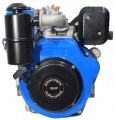Shaft type
Shaft type, more precisely, the type of fastening for the hub provided on the shaft shank.
Recall that a hub is a part with a hole that is put on the shaft; it is through this part that the rotation is transmitted to the mechanism with which the engine is used. The general rule in this case is this: the type of shaft must match the type of mounting on the hub, otherwise normal operation will not be possible. Nowadays, there are units with shafts
under the key,
under the spline,
under the cone and
under the thread. Here is a more detailed description of each option:
— Dowel. Connection using a key — an elongated part placed in a special longitudinal groove. More precisely, there are two grooves: one is located on the shaft, the other is on the hub, and the key is tightly installed in the space formed by the grooves and connects the shaft and the hub. Such connections are simple and at the same time quite functional, due to which they are widespread and found in engines of all price and “weight” categories. On the other hand, a keyed connection is less secure than a splined connection and is less suitable for high RPM and/or heavy loads.
— Slots. Connection based on slots — longitudinal slots. Most often, there are six of them on the shaft, and the seat on the hub has the appropriate shape — in the form of a charac
...teristic asterisk. A spline connection is more complicated and more expensive than a keyed connection, and numerous slots reduces the strength of the shaft and it has to be made thicker. However, the connection itself is very reliable, as it evenly distributes the load during rotation. Therefore, splines are recommended for work at high loads.
— Cone. A shaft with a shank in the form of a cone (tapering towards the end), in the centre of which there is a hole with an internal thread. It is used quite rarely, mainly on fairly powerful units — from 7 hp. and higher.
— Carving. Cylindrical shank with external thread. A rather specific option that has not received much distribution — in particular, due to the fact that the thread tends to loosen from vibrations as it is used, and significant efforts may be required to connect and disconnect the shank and hub.Start type
Regular way to start the engine. To start an internal combustion engine, crankshaft rotation is required, and different types of start differ depending on how this cranking is provided:
— Manual. Starting due to the muscular strength of the operator: usually, to rotate the shaft, you need to pull a special cable, although other options are possible (for example, a starting handle). Manual systems do not require batteries and are generally simple, compact, low cost and reliable; in fact, except for a person, nothing is required to start. On the other hand, the procedure is not very convenient for the user himself: you need to pull the cable quite strongly and sharply, which can be difficult, especially if you are not used to it. Also note that this method is of little use for powerful heavy engines.
- Electric starter. Starting due to a separate electric motor (starter), turning the shaft. Power for the motor is provided by a special battery. This method is much more convenient than manual, because. the user, in fact, just needs to press a button; at the same time, it is suitable even for the most "solid" motors. At the same time, the starter and battery significantly affect the price, weight and dimensions of the engine, and with a dead battery, the entire system becomes useless (however, an “emergency” manual start may be provided for this case).

